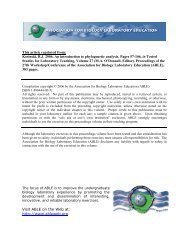Organelle Isolation and Marker Enzyme Assay - Association for ...
Organelle Isolation and Marker Enzyme Assay - Association for ...
Organelle Isolation and Marker Enzyme Assay - Association for ...
You also want an ePaper? Increase the reach of your titles
YUMPU automatically turns print PDFs into web optimized ePapers that Google loves.
140 <strong>Organelle</strong> <strong>Isolation</strong><br />
Expected Results<br />
APPENDIX A<br />
Expected Results <strong>and</strong> Examples of Assignment Questions<br />
The results presented in Table 8.4 <strong>and</strong> Figure 8.4 indicate that the first spin (Sample B) brings<br />
down in the pellet most of the mitochondria without any significant amount of contractile vacuoles,<br />
giving excellent separation between these two organelles. The second spin (Sample C) pellets most<br />
of the lysosomes in addition to mitochondria while contractile vacuoles are still in the supernatant.<br />
The third spin pellets all markers indicating that they are pelletable organelles. This simple<br />
experiment implies that these three spins sequentially brings down mitochondria, lysosomes, <strong>and</strong><br />
contractile vacuoles, respectively.<br />
Table 8.4. Expected results (an example from a student's notebook).<br />
Succinate<br />
Acid<br />
Alkaline<br />
dehydrogenase phosphatase<br />
PDE<br />
Fraction A630 f A410 f A410 f<br />
A 0.7 0 0.58 0 0.83 0<br />
Bp 0.6 0.8 0.195 0.3 0.072 0.08<br />
Bs 0.15 – 0.455 – 0.83 –<br />
Cp 0.78 0.98 0.426 0.71 0.2 0.23<br />
Cs 0.02 – 0.174 – 0.67 –<br />
Dp 0.81 0.98 0.59 0.87 0.713 0.8<br />
Ds 0.02 – 0.09 – 0.167 –<br />
Examples of Assignment Questions<br />
1. Based on your results, how would you propose to separate organelles X <strong>and</strong> Y from<br />
mitochondria, lysosomes, <strong>and</strong> contractile vacuoles in one experiment employing not more than<br />
three steps of centrifugation? (Answer in 5–7 lines.)<br />
<strong>Organelle</strong> X sediments at 5.0 × 10 6 RCF-min<br />
<strong>Organelle</strong> Y sediments at 1.0 × 10 3 RCF-min<br />
Answer: Spin first at 1.0 × 10 3 RCF-min to pellet only organelle Y. The supernatant is then to be<br />
spun at 5 × 10 5 RCF-min to remove in the pellet mitochondria, lysosomes <strong>and</strong> contractile<br />
vacuoles (see Table 2). The supernatant which now contains only organelle X could be spun at<br />
5 × 10 6 RCF-min to pellet organelle X.<br />
2. As you know, materials ingested by cells are sent to lysosomes while mitochondria are involved<br />
in oxidative phosphorylation (ATP synthesis). How would you propose to separate them if they<br />
happen to sediment at the same RCF-min <strong>and</strong> have the same density on density gradients?<br />
(Answer in 3–4 lines.)
















